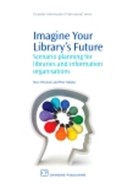0%
21Chapters
0-1Hours read
0kTotal Words
Book Description
In this information age it is widely recognised that, in order to maintain relevance and to gain a competitive edge, libraries and other organisations in the business of information must continuously assess their roles, collections, services and perhaps most importantly, their business practices. Scenarios are a way of predicting and describing a future three to five years away while strongly engaging one’s community in choosing the future which is preferable. The horizon in which assessments about future roles change is growing shorter and shorter. While it is almost clichéd to state that change is the only constant, differing scenarios of what libraries might be allow all of us to contemplate futures we might otherwise not allow. Drawing on extensive experience in libraries in different parts of the globe, the authors provide a rich analysis of planning, managing and implementing change in information organisations through scenario planning. Through extensive practical applications, both actual and theoretical, the authors provide a strong background understanding and direct the reader through a planning process that is both readily applicable and innovative for all information organisations, irrespective of their size or client base.- Extensive exploration of what it means to ‘shape our futures’ rather than having our future shaped for us
- Valuable techniques for understanding futures and creating different scenarios
- Practical applications are illustrated through examples and real life experience
Table of Contents
- Cover image
- Title page
- Table of Contents
- Copyright
- Dedication
- Preface
- Acknowledgments
- List of figures, table and case studies
- About the authors
- Chapter 1: What are scenarios?
- Chapter 2: The complexities of our informational environment
- This chapter
- What is the environment?
- Libraries and their environments
- Disruptive technologies
- Broad disruptive technological impact on libraries
- Issues in the wider environment
- Open source
- Open source implications
- Digital content
- Digital content implications
- The author–publisher–library relationship
- Content balance
- The future of work
- Implications for the future of work
- Emerging trends
- Chapter 3: The future and the past: models are changing
- Chapter 4: Understanding choices
- Chapter 5: Toward a new way of thinking
- Chapter 6: Designing your process
- Chapter 7: Scenarios and implementation
- Chapter 8: Choice, chance and (less than) certainty
- Chapter 9: Case studies
- Chapter 10: Implementation and the impact of change
- Further reading
- Index
